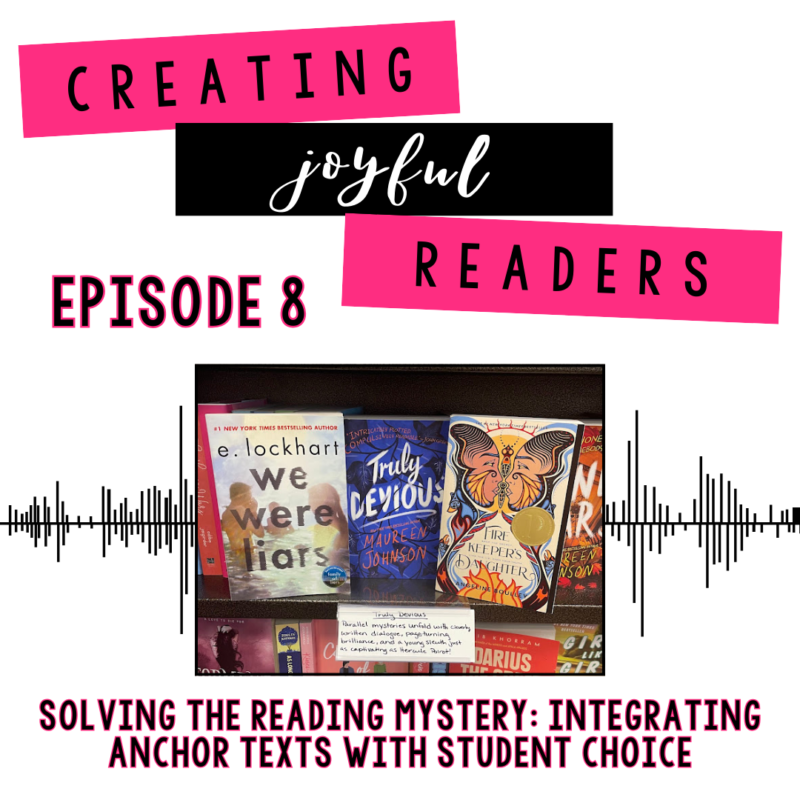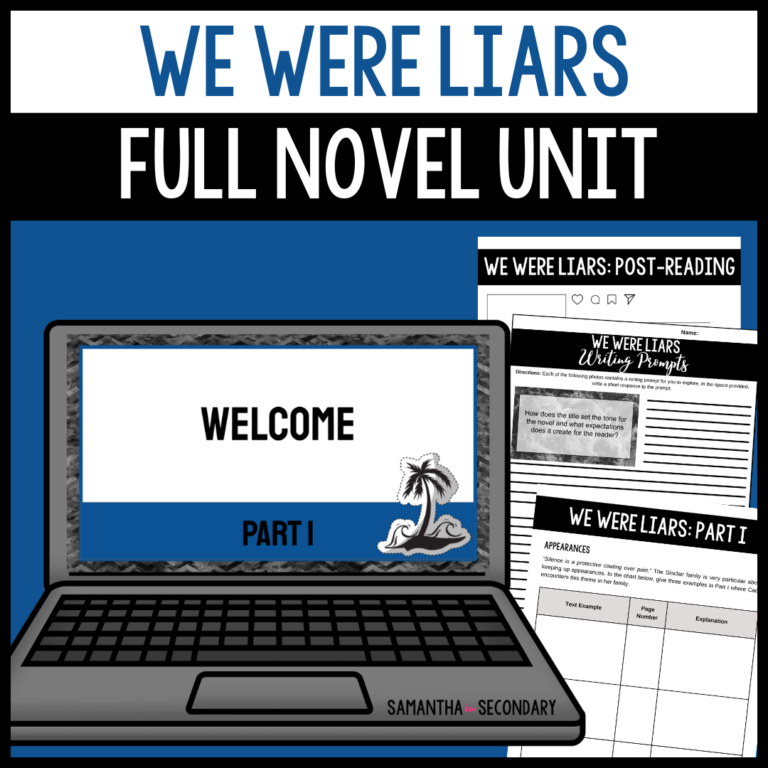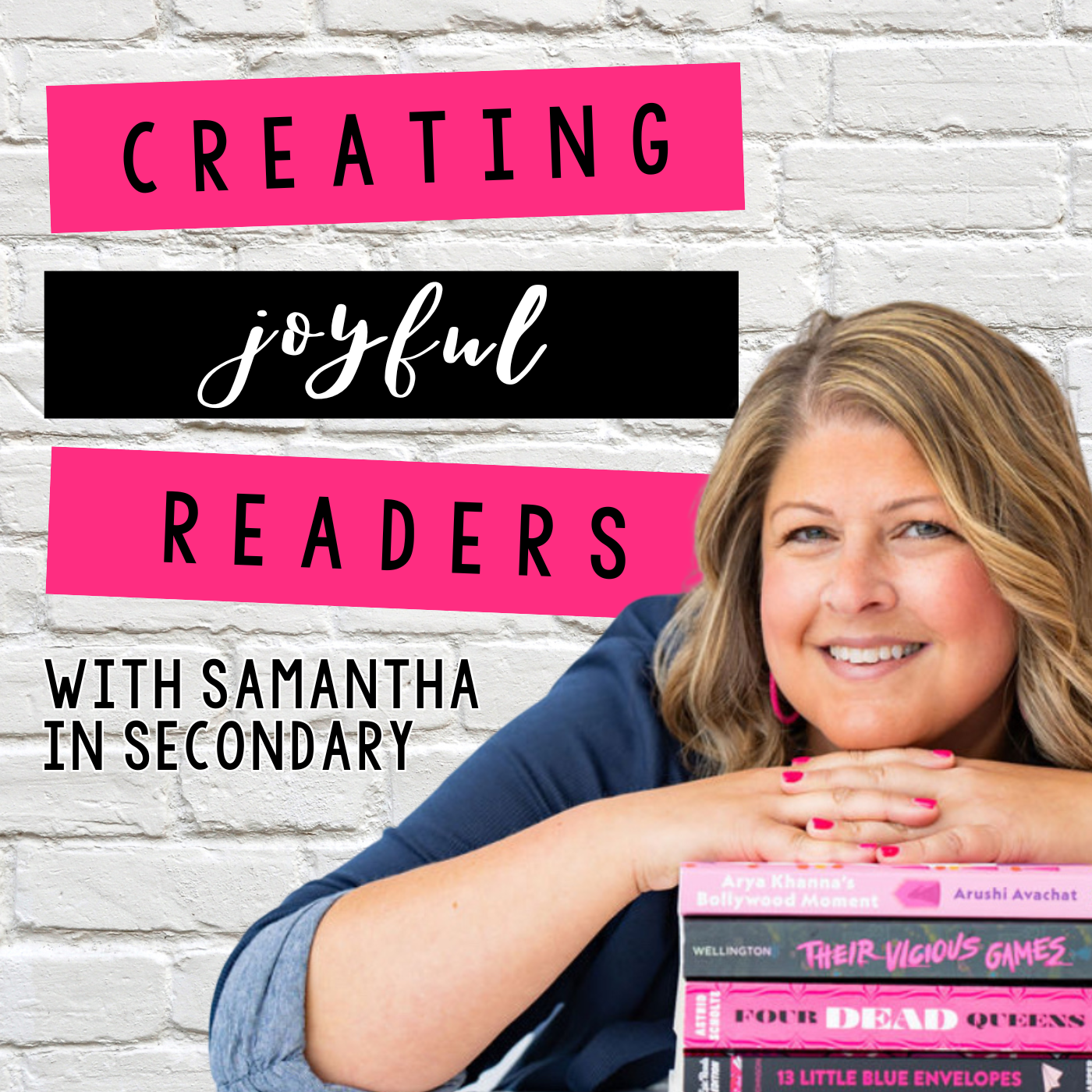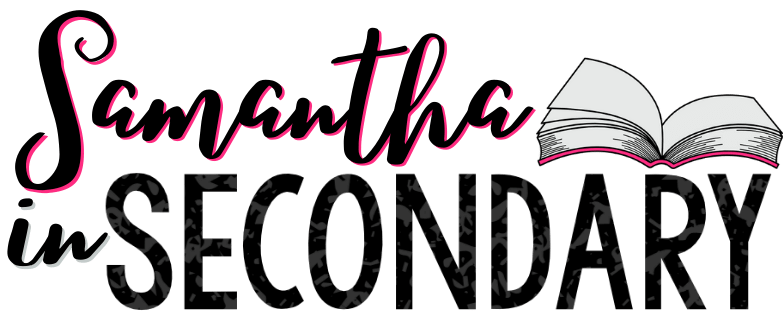Samantha 00:00
Like most other teachers, I was absolutely frightened when I was told I needed to run a choice reading unit. How will I keep track of everything? How do I manage a class full of students reading different books? These questions kept me up at night. I then realized then that I was expected to do this alongside my regular curriculum, and then my mind was really blown. Thankfully, after years of trial and error, I got pretty good at it, and it helped me realize why this is such a powerful practice. In today’s episode, I’m going to give you my best recommendations for anchor text in the mystery genre, and then I’m going to give you practical strategies I learned over years of practice to implement these novels seamlessly beside a choice reading unit in the same genre. Buckle up, joyful readers, you’re in for a good one.
Samantha 00:46
Welcome to Creating Joyful Readers, a podcast dedicated to empowering secondary educators with the tools, strategies, and inspiration to cultivate a lifelong love of reading in their students. I’m your host, Samantha. Tune in each week as we explore the transformative power of independent reading. Delve into the latest research on literacy, dissect projects that will help your students showcase what they’ve learned in a unique way, and share curated recommendations of young adult novels that will captivate and engage your learners. Join in as we embark on a journey to create joyful lifelong readers one book at a time.
Samantha 01:24
Let’s start with talking about an anchor text. Your anchor text is the central text that serves as a foundation for your unit. These should be rich texts that include layered themes that discuss the universal human experience. It should be something all students can get something out of or connect to. Choosing an anchor text for your unit can be difficult, but it’s important to make sure you choose one that’s going to be complex enough to drive the entire unit. A note about planning an entire unit, I don’t think there’s a one size fits all approach to unit planning. You should have an overarching theme or idea to tie the unit together, but what that is should be left up to what feels most natural to you. Personally, I love to plan units that start with a genre, add in a key literary element, develop some essential or focus questions, and then pull a few focus standards. Most of these occur naturally because I start with a specific genre. I’ll give you an example. For the mystery genre, the literary element that nicely aligns with the genre is plot. So one focus question I might use would be, what elements a plot structure are emphasized in mysteries? Why is this necessary for the genre? My focus standard would be RL 5: analyze how an author’s choice is concerning how to structure a text order events within it, eg, parallel plots and manipulate time, eg pacing, flashbacks create such effects as mystery, tension or suspense. I choose my anchor text carefully to make sure it clearly exemplifies the genre, is appropriate for my specific group of students, and is meaty enough to carry a unit. We’ll get into this more later. Then I’d create my learning experiences, as well as my assessments, and add in all of those important routines that help students gain important literary skills, like vocabulary, close reading, and selected grammar lessons. I weave all of this together to create my perfect unit. Again, I don’t think there’s a one size fits all approach to unit planning. So if this doesn’t make sense to you, figure out what does. Try a few things until you get comfortable. You may have required information you have to include, or even required books you have to use so consider that as well. I truly believe good unit planning takes years of trial and error to perfect, so don’t be afraid to get in there and let it be messy. It’s the only way you’re going to learn what works for you. When the unit is clear and exciting for you, your students are going to get so much more out of it. Okay, let’s talk anchor texts. I have three specific novels that I think would make excellent anchors for a mystery unit. I’m going in order of both reading level and appropriateness for students’ age.
Samantha 03:54
My first choice is We Were Liars by E Lockhart, this is the first novel we’re going to talk about. I actually had the privilege of being able to teach this one and have a full novel unit ready in my shop, Samantha in Secondary on teachers pay teachers. If you decide you’d like to teach it as well and would like some support, you can head to my shop or just head to the show notes, and I’ll have a link for you there. We Were Liars bcy E Lockhart is a suspenseful novel that follows the story of Cadence Sinclair, a teenage girl from a wealthy family who spends her summers on their private island after a mysterious accident leaves her with memory gaps and severe migraines. Cadence struggles to piece together what happened during her 15th summer as she reconnects with her cousins and friends known collectively as the liars. She uncovers shocking truths about her family and the events that led to her trauma. It’s a great time to teach this novel, because Amazon is actually in production to create a TV show. A release date hasn’t been announced yet, but they did cast the liars already. This novel is best for seventh grade and up. It’s a shorter novel at 320 pages, and though the Lexile level is fairly low, at about 600 there are so many upper level themes to explore. A few content warnings to consider would be the mention of death and suicide, but it’s mostly done in metaphor. The book does allude to a serious accident for the entirety of the book, and it does turn out to be fairly violent. There are no graphic sexual details, just kissing. There is a nod to underage drinking, and the protagonist thinks she might be addicted to the Percocet she’s been taking for pain. It’s definitely on the tamer side for the young adult genre. I have five reasons why you should use this novel. First is engagement. We Were Liars is extremely engaging. The first time I read it, it had me in a chokehold until clear up to the end, where I audibly gasped. And through the book, it has such a clever twist ending that got me so good. And my experience, most students do not see it coming either. Complex characters. The novel’s characters are multifaceted and undergo significant development, providing students with opportunities to analyze character, motivations, relationships and growth. The protagonist, Cadence Sinclair, is particularly intriguing as she uncovers the truths about her past. We Were Liars, employs a variety of literary techniques, including unreliable narration, flashbacks and symbolism. These elements make it an excellent text for teaching literary analysis and helping students identify and understand complex narrative structure and devices. The fourth reason would be emotional and moral depth. The novel deals with intense emotions and moral dilemmas, encouraging students to empathize with characters and consider ethical questions. The emotional depth can foster discussions about real life issues and help students develop critical thinking and empathy. And lastly, contemporary relevance set in a modern context. We Were Liars addresses issues that are relevant to today’s teens, such as mental health, family pressure, and the search for personal identity. This contemporary relevance can make the novel more relatable and engaging for students, promoting a deeper connection to the text. Using We Were Liars in the classroom can provide a rich and engaging experience for students, combining compelling storyline with valuable learning opportunities. I highly recommend this text. And as I said before, if you want a head start, check out my shop, Samantha In Secondary for a full ready to teach unit.
Samantha 07:08
The second book I want to recommend is Truly Devious by Maureen Johnson. Truly Devious remains one of my all time favorite YA mysteries. It’s unique in that although it’s a mystery, it reads a little bit like historical fiction, that angle made it feel really fresh when held up against other titles. It also has characters you will grow so attached to. The series is now five books in, and while I don’t love them all equally, I still very much enjoy all things Stevie Bell. Ellingham Academy, a prestigious private school in Vermont, founded by tycoon Albert Ellingham, is known for its enigmatic campus and the infamous unsolved kidnapping of Ellingham’s wife and daughter, linked to the cryptic, Truly Devious riddle. True Crime enthusiast Stevie Bell begins her first year at the Academy with the ambitious goal of solving this cold case. However, she must first navigate the challenges of her new school life and her eclectic housemates, including an inventor, a novelist, an actor, an artist, and a jokester. This novel is best for students in grades nine and up. The paperback is 448 pages, so it is a bit of a commitment. The Lexile is estimated at 680 which is slightly low for high school. But again, the rigor is in the exploration of the themes, because there is a lot to dig into. Truly Devious bounces between alternate timelines. In the present, there is one death, and talk of sex and kissing, but nothing is open door. There is some underage drinking, but the main character does not often partake and doesn’t seem to be pressured into joining. In the past, adults drink whiskey and smoke with talk of many speakeasy parties during prohibition. There is a kidnapping and several deaths are explored in the 1930s timeline. The book also does explore the criminal mindset quite a bit as well. Again, I’m going to give you five reasons why you should teach truly devious. First, a strong genre. Example, Truly Devious features a gripping and intricate mystery that captivates students’ attention and encourages critical thinking and problem solving skills as they follow Stevie Bell’s quest to solve a decades old crime. Number two, strong, relatable protagonist. Stevie Bell is a relatable and inspiring protagonist whose passion for true crime and determination to uncover the truth can motivate students pursue their interests and think critically about the world around them. Stevie Bell remains to this day one of my favorite YA protagonists. Number three, exploration of themes. The novel delves into themes such as the pursuit of knowledge, the nature of truth and the impact of past events on the present. These themes provide rich material for classroom learning, helping students develop their analytical and literary skills, integration of historical and contemporary elements truly devious, seamlessly blends a historical crime with modern day investigation, offering students a unique perspective on how history can influence the present. This dual timeline approach can enhance students’ understanding of historical context and its relevance to contemporary issues. Last but not least. Five promotes critical thinking and literary analysis. The novel’s complex narrative structure, including flashbacks, multiple perspectives and red herrings, challenge students to think critically and engage in deeper literary analysis. Teachers can use these elements to teach narrative techniques and encourage students to consider different narrative viewpoints and their effects on storytelling. Truly Devious continues to be a favorite among students and teachers alike. I strongly suggest picking up a copy and giving it a read to see if it would be a good fit for your students.
Samantha 10:29
The last book we’re going to discuss today is Firekeeper’s Daughter by Angeline Boulley. Firekeeper’s Daughter is an incredibly decorated novel. It has four starred reviews and has won a Printz, a Morris, and countless other awards with a list so long I’d need an entirely new episode to list them all. The narrative is incredibly compelling, and while it’s definitely a commitment, it’s one worth making. 18 year old Daunis Fontaine, caught between her hometown in the Ojibwe reservation, postpones her college dreams to care for her mother after a family tragedy. Her life takes a drastic turn when she witnesses a murder and becomes involved in an FBI investigation into a deadly new drug, using her chemistry knowledge and Ojibwe traditional medicine to go undercover. As Daunis uncovers hidden truths and faces personal and communal challenges, she learns the true meaning of being an Anishinaabekwe and the lengths she’ll go to protect her community. There are a lot of content warnings for this novel, so while I’ll try to cover some of them here, this is one of those novels you’re going to need to vet thoroughly before introducing to your classroom. While it is extremely valuable in educational context, it is also very heavy and comes with a lot of topics that will need to be discussed with extreme sensitivity. In no particular order, and by no means an exhaustive list here are some things you can expect. Murder, rape, physical violence, casual references to sex, but no open door scenes, adultery, substance abuse, absolutely not glorified in any way, but it is a very large part of the narrative, drinking, tobacco use. With such a large list of content warnings you might be wondering why it would even be worth it to try to use this novel with students. Let me dive right into that now with five reasons. First, cultural representation and diversity. The novel provides rich insights into Native American culture, particularly the Ojibwe community. Teaching this book can help students appreciate diverse perspectives and understand the complexities of cultural identity. This was, personally one of my favorite aspects of the book. I absolutely loved how much I learned about the Ojibwe community. Listening to the audio really helped me understand the pronunciations as well. Number two, contemporary and relevant themes, the book addresses important contemporary issues such as substance abuse, systemic racism and the struggle for justice. These themes are highly relevant to today’s societal context and can stimulate critical discussions among students about current events and social justice. Number three, strong female protagonist, Daunis Fontaine, the protagonist, is a strong, intelligent and resourceful young woman who navigates her mixed heritage and personal challenges. Her character can serve as an inspiring role model for students, particularly in terms of resilience, moral integrity and the importance of community. Number four, complex and engaging plot, the novel’s intricate plot, which blends elements of a thriller with a coming of age story, can captivate students’ interest and motivate them to engage deeply with the text, the suspensible narrative and well developed characters provide ample opportunities for literary analysis and discussion. Last, number five, exploration of identity and belonging. Firekeeper’s Daughter delves into themes of identity, belonging, and the search for self. These universal themes resonate strongly with high school students who are at this stage of their lives. The novel can thus facilitate meaningful personal reflection and discussion. Firekeeper’s daughter is an excellent novel and can be very powerful with students in 11th or 12th grade. That is my official recommendation for the grade level. Even though the Lexile level is around 720, it’s also a very long novel coming in at 512 pages for the paperback. So definitely take that into consideration when you’re evaluating the book for your own classroom.
Samantha 14:04
Many ELA curriculums require that you run a choice reading unit alongside your main text in the mystery genre. You can find ways to overlap the components of your main unit in order to incorporate both your anchor text and your literature circle selections in a way that will allow your students to compare and contrast examples of the genre. As I said earlier, plot is my favorite literary element to discuss when studying mysteries, because authors in this genre love to play with the plot in order to make the story more interesting. You can have students compare the plot of the anchor text with the literature circle selection to see which they found more engaging. It also might be a fun exercise to have students write the main plot points on index cards and reorganize them to try to enhance the mystery. You should also consider requiring students to use both of the texts when completing a unit project. I’ll talk more about supplementary activities in a future episode. There are so many opportunities for deep comparative analysis when you structure your assessments in this way.
Samantha 14:59
So in this episode, we’ve chatted a little bit about the function of an anchor text in your curriculum, and then discussed my three favorite anchor text choices for the mystery genre. We Were Liars by E Lockhart, Truly Devious, by Maureen Johnson,and Firekeeper’s daughter, by Angeline Foley. Next week, we’ll talk about literature circle selections to guide your choice reading units so you can have plenty of options for students to check out when you launch this unit in your own classroom. For more information, check out the show notes. Until next time, happy reading.
Samantha 15:29
Thanks for tuning in to creating joyful readers. I hope you found inspiration and practical strategies to ignite a passion for reading in your students. Remember every book we introduce and every reading experience we foster can transform lives and help students become lifelong readers. Follow me on social media at Samantha in secondary for more tips book recommendations and to connect with a community of educators dedicated to making reading a joyful journey. Until next time, happy reading.








